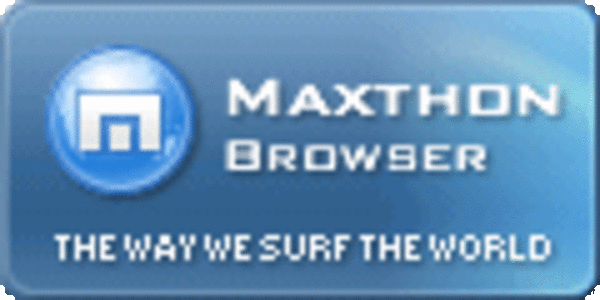Written by Gang Lu and edited by Richard MacManus. Original version posted on Gang
Lu’s blog The MObilenoDE.
Maxthon (formerly known as MyIE) is a browser that
reportedly has 30% of the browser market in its home country of China, second only to IE
and ahead of Firefox. It is a powerful tabbed, fully customizable and 100% free Internet
browser built on top of Microsoft’s Internet Explorer (IE) platform. The milestone
Maxthon 2.0 beta was released early last month. We carried out an in-depth interview with
SVP & Partner at Maxthon Netanel
Jacobsson (former Business Development Director at AOL/ICQ), who told us the full
story of this exciting browser and its bid for global success.

The History of Maxthon
The interview starts with a bit of history about Maxthon, a browser generally not well
known in the Western world. Netanel said that MyIE was originally created by a Chinese
man called Changyou, who wanted to customize his IE browser. MyIE became the first
browser to support tabbed browsing. Changyou posted most of the code onto his BBS, but
unexpectedly left the project due to personal reasons in 2000. Luckily, one of his
admirers Jeff Chen decided to continue the development and released a new version with
the name MyIE2. MyIE2 grew very fast, with massive contributions from passionate
users all over the world. They communicated via BBS, Forums and IM – and helped on
developing the plugins, sites, skins, debugging, etc.
Netanel said that Maxthon users are very passionate about the IE browser, but they
want more from IE than Microsoft provided – so they formed a community to build and
maintain Maxthon.
MyIE2 was renamed Maxthon in 2003. It was seed funded by the first Skype investor
Morten Lund, together with WI Harper
Group in 2005. In 2006 Maxthon received a major investment from US-based VC firm
Charles River Ventures.
More than IE – The Features of Maxthon2 Beta
In early November 2006, the
Maxthon 2.0 beta was released –
featuring a completely re-designed UI and core code. Still, Maxthon 2.0 beta is fully
compatible with Internet Explorer. It has the same basic browsing
functionalities, but also provides many rich features to improve the surfing experience.
Some of the highlights are:

- Advanced proxy function – allows the use of different proxies for
different web sites, ensuring the best browsing speed and web site accessibility. - User Interface Multi-Thread technology– greatly reduces the
chance of browser lockup, (e.g. caused by some Ajax operations) and browser crashes. - Modular design – loads only the required components, ensuring the
most efficient use of system resources. - Highly customizable skinning and interface system – supports
anything from the simple windows classic to the most crafted skins and advanced
layouts. - Ultra powerful filter – the system can filter not only ads, but also
any malicious code; removing web annoyances and improving browser safety. - Multi-users password – protected profile system protects users
privacy without compromising program portability.
People always complain about IE’s security issues (even the newly released IE7)
and its non-compliance with many standards. Netanel said that the Maxthon 2.0 beta
provides Online Maxthon Security Updates to reduce the risks of certain
un-patched Internet Explorer vulnerabilities; and Maxthon Smart
Acceleration (MSA) technology significantly improves browsing speed. He said the
Maxthon team is working hard to fully support the Gecko engine, which
will be added to Maxthon 2.0 final version.
The Browser Market in China
The Chinese browser market is dominated by IE and Maxthon – Firefox usage is very
low in China. I asked Netanel about the 30% market share that Maxthon reportedly has in
China. Netanel said it’s actually very hard to give an exact figure to show how
popular Maxthon is in China, because sometimes Maxthon is still counted as IE in the
figures. Netanel said:
“We have 12 million active users monthly and over 73
million downloads [over] the world. There is no doubt Maxthon is the second
after IE in China and I also hope the market share will be more than 30%
very soon.”
Maxthon’s Revenue
Netanel said that Maxthon’s revenues are mainly from search, but also from
subscription services and donations. He said that other business models would be
introduced soon. It is very interesting to note that Maxthon has been revenue
positive since 2005, with a stable business model and low burn rate – not many startups
can match that today.
Maxthon in 2007
Maxthon is actually the only Chinese Internet Software company with a
global presence. With its success in China and the brilliant features in Maxthon 2.0,
Maxthon is ready for the worldwide market. Netanel said they are growing very fast globally,
especially in the US. Also a lot of new users are young, which is a good trend for
Maxthon.
In 2007, Maxthon will be working actively with local communities in the US and Europe.
It will start organizing Maxthon meetups and developer conferences, to officially
show the power of Maxthon and promote its presence in the global market.
“We will bring fresh air to the [browser] world in the coming new year”, Netanel
added.
I asked Netanel about the final release of Maxthon 2.0. Netanel said he hoped
it would be sometime in the spring 2007.
Netanel concluded by describing Maxthon as a grass roots movement, more than a product
– due to the support of its passionate world-wide user community. Netanel said:
“[…] We can see that the role of the browser is changing and is becoming the
focal point of customization and personalization. It is the place where users can choose
to run their applications and in this sense it is kind of taking over the role of the OS.
[…] Maxthon is going to become a major platform for the delivery of the new web
services and you can expect to see some interesting examples of this during
2007[…]. “
Written by Gang Lu. See also Read/WriteWeb’s
Web Browser Faceoff.










